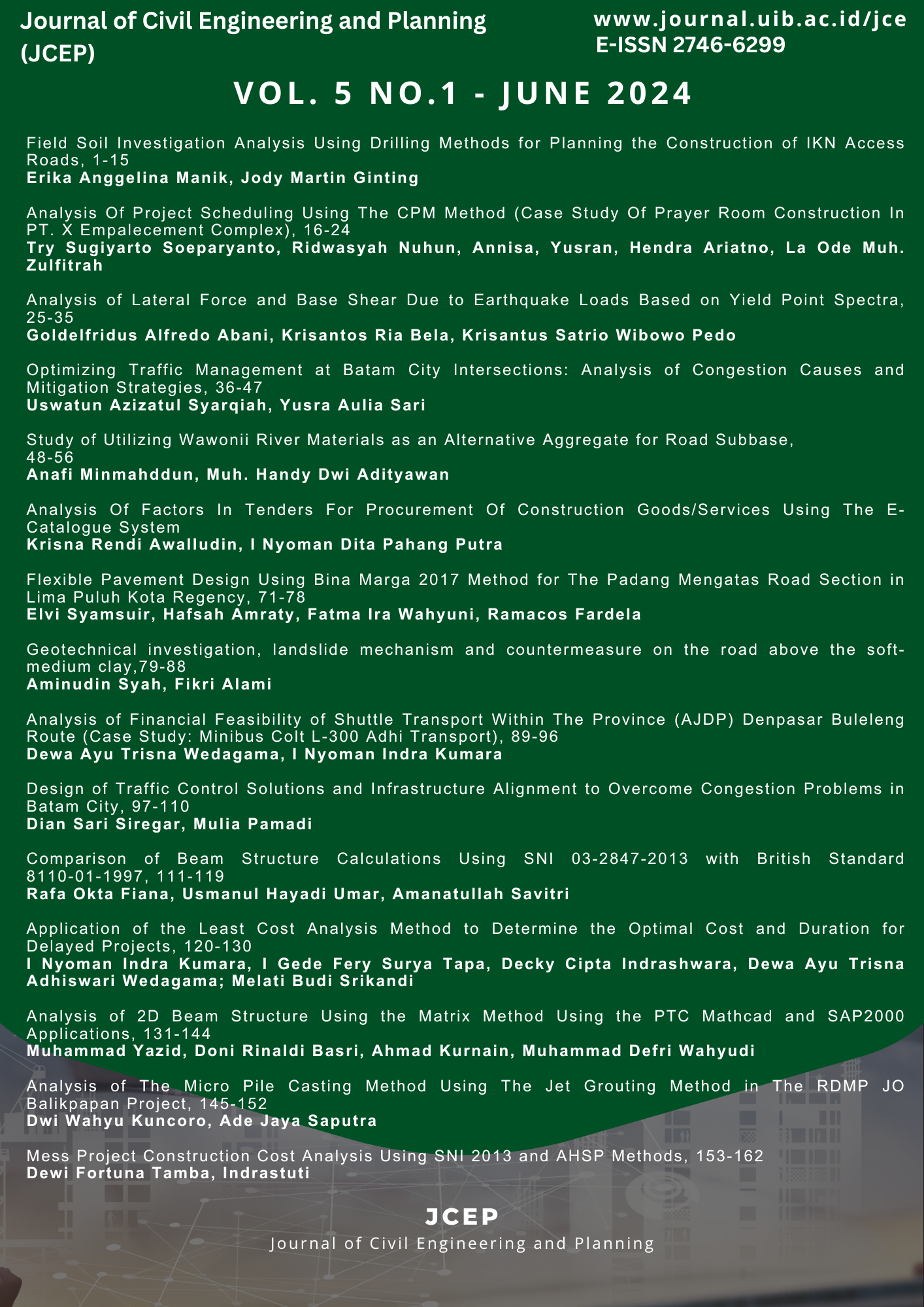Geotechnical investigation, landslide mechanism and countermeasure on the road above the soft-medium clay
DOI:
https://doi.org/10.37253/jcep.v5i1.9373Keywords:
landslide, groundwater level, countermeasure, safety factorAbstract
A landslide event occurred in Sukarami, Lahat Regency, in early 2024. This study investigates the landslide mechanism, analyzes the influence of groundwater level rise and load on slope stability, and proposes a management concept. The methodology employed a landslide survey, soil investigation, and limit equilibrium-based stability analysis. Field investigations and surveys revealed that the landslide resulted from a decrease in the shear strength parameter of the surrounding soil layer triggered by rainfall and road drainage runoff. The slip plane, located within a soft to medium consistency clay layer, exhibits high susceptibility to water-induced instability. Numerical simulations demonstrated a negative correlation between groundwater level and slope safety factor, particularly when the water table reaches the critical slip plane. The implementation of a combined gabion, DPT, and minipile reinforcement system can enhance slope stability and elevate the safety factor to meet established standards. Notably, the addition of vehicle loads up to 30 kN/m2 exerted an insignificant influence on slope stability.
Downloads
References
Haji Azizi M, Kielanei F, Kielanei P. (2015) Comparison of the methods of limit equilibrium in slope stability of embankments. In: First national conference on soil mechanics and engineering, Faculty of Civil Engineering, Shahid Rajaee University.
Hardiyatmo, H.C. (2014) Mekanika Tanah II, Gadjah Mada University Press, Yogyakarta
Steward T, Sivakugan N, Shukla SK, Das BM (2011) Taylor’s slope stability charts revisited. Int J Geo-mech ASCE Vol. 11 (4) , pp 348–352
Salmasi F., Pradhan B., and Nourani B., 2019. Prediction of the sliding type and critical factor of safety in homogeneous fnite slopes. Applied Water Science, Vol. 9, pp 158
Gaopen T., Lianheng Z., Liansheng G., Wei L., (2014) Stability Charts for Undrained Clay Slopes in Overload Conditions Based on Upper Bound Limit Analysis, Electronic Journal of Geotechnical Engineering Vol. 19:1531-1537
Arif M., dan Ilpandari (2022) Pengaruh Galian Terhadap Stabilitas Lereng Tanah, Journal of Civil Engineering and Planning, Vol.2 No.1 pp. 171-179
Das, B. M. (2010). Principles of Geotechnical Engineering. Cengage Learning: USA
Bishop, A.W. Morgenstern N.R. (1960). Stability coefcients for earth slopes. Geotechnique Vol. 10(4), pp 129–147
Janbu N (1973) Slope stability computations. In: Hirschfeld E, Poulos S (eds) Embankment dam engineering, Casagrande memorial volume. Wiley, New York, pp 47–86
Morgenstern, N.R., and Price, V.E. 1965. The Analysis of the Stability of General Slip Surfaces. Geotechnique, Vol. 15, pp. 79-93.
Karnawati, D., 2005. Bencana Alam Gerakan Massa Tanah di Indonesia dan Upaya Penanggulangannya. Jurusan Teknik Geologi, Fakultas Teknik, Universitas Gadjah Mada, Yogyakarta.
Syah, A., Dani, I., Erfani, S., 2020. Analisis Stabilitas Lereng dan Penanganan Longsor Metode Kontrol dan Perkuatan (Studi Kasus: Longsor Waikerap, Tanggamus, Lampung). Borneo Engineering : Jurnal Teknik Sipil. Volume 4 Nomor 2: 180-191
Melo, C. dan Sharma, S., 2004. Seismic Coeficient for Pseudostatic Slope Analysis. Vancouver.
Hynes-Griffin M.E., dan Franklin A.G. (1984) Rationalizing the Seismic Coefficient Method. Department of the Army Waterways Experiment Station, Mississippi USA.
Arif M., dan Adriyati M. (2021) Pemodelan 2D Tanah Likuefaksi Menggunakan Quake/W, Journal of Civil Engineering and Planning, Vol.2 No.1 pp. 171-179
Downloads
Published
Issue
Section
License
Copyright (c) 2024 Aminudin Syah, Fikri Alami

This work is licensed under a Creative Commons Attribution 4.0 International License.



_0011.jpg)









